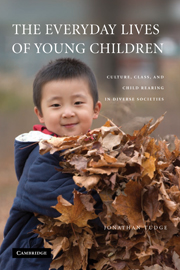Book contents
- Frontmatter
- Contents
- Preface
- Acknowledgments
- 1 Introduction and Stage Setting
- 2 The Daily Lives of Toddlers
- 3 Cultural–Ecological Theory and Its Implications for Research
- 4 Methods
- 5 Life in the Cities
- 6 Everyday Activities
- 7 Settings and Partners
- 8 Everyday Lives
- 9 The Cultural Ecology of Young Children
- References
- Index
7 - Settings and Partners
Published online by Cambridge University Press: 25 July 2009
- Frontmatter
- Contents
- Preface
- Acknowledgments
- 1 Introduction and Stage Setting
- 2 The Daily Lives of Toddlers
- 3 Cultural–Ecological Theory and Its Implications for Research
- 4 Methods
- 5 Life in the Cities
- 6 Everyday Activities
- 7 Settings and Partners
- 8 Everyday Lives
- 9 The Cultural Ecology of Young Children
- References
- Index
Summary
I've seen men as are wonderful handy wi' children.
George Eliot, Silas Marner, 1861/1985, p. 180In this chapter, I focus on the various types of settings in which the children were situated during the times that we observed them, their partners during their activities, and variations in the activities because of being with certain types of partners or in one setting rather than another. Remember that when we selected the children for the project, we paid no attention to whether they attended any type of child-care arrangement or where they spent their time, and acceptance to the project was not dependent on the presence or number of siblings, whether the biological father was present, or any other similar factor. The sole concern was that we wanted to recruit all the families with children of the relevant age from the areas that we had selected, the sole criterion being that the families met our requirements for membership in the relevant ethnic and social-class group.
If it were the case that in any group many of the children went to a child-care center, or many of the fathers were absent from the home, or if most of the families had just the one child, we assumed that this simply reflected the prevailing ecology, particularly because of the ways in which we recruited the families and the generally low rejection rates (see Chapter 5).
- Type
- Chapter
- Information
- The Everyday Lives of Young ChildrenCulture, Class, and Child Rearing in Diverse Societies, pp. 185 - 220Publisher: Cambridge University PressPrint publication year: 2008



